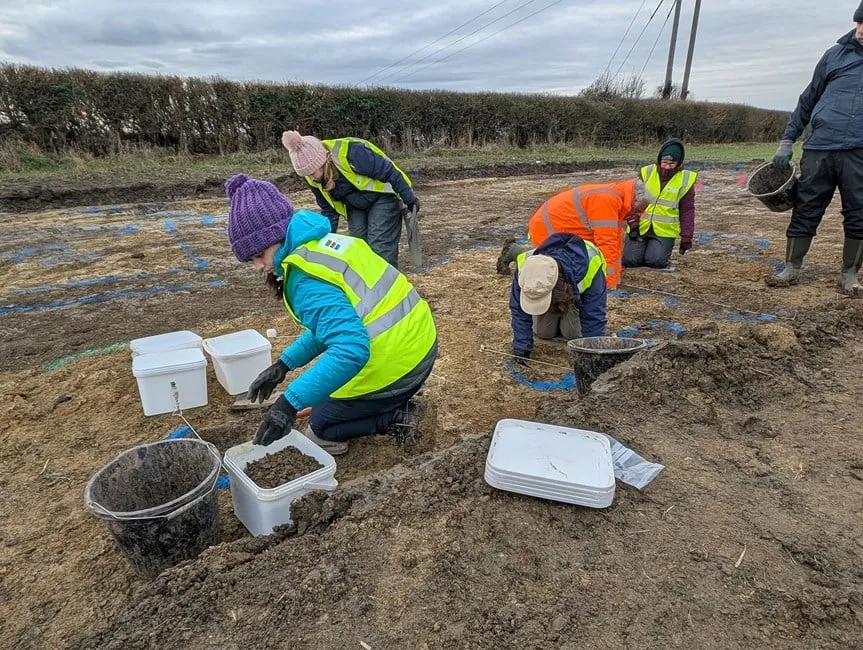Archaeologists Unearth Traces of an Iron Age Settlement and Roman Villa in England
The excavation, which followed the discovery of two Roman swords in 2023, is providing historians with fresh insights into Britain’s ancient history

Archaeologists in England’s Cotswolds region have unearthed a large Iron Age settlement—and the ruins of what could be a Roman villa built on top of it.
The excavation took place near the village of Willersey in Gloucestershire, where two 1,800-year-old iron Roman-era swords were discovered during a metal detecting rally in 2023. Detectorist Glenn Manning found them on his second-ever search for treasure, reports PA Media’s Rod Minchin.
Quick fact: The Romans in Britain
The Roman invasion of Britain began under the emperor Claudius in 43 C.E.
The weapons had already been damaged by farm equipment. If they hadn’t been found, they could easily have been destroyed.
“It was phenomenally lucky,” Peter Busby, a project officer for Cotswold Archaeology, tells the Guardian’s Steven Morris. “The swords were within half an inch, no more than an inch, of oblivion.”
Found inside their wooden sheaths, these weapons are likely a kind of long sword known as a spatha, which Roman soldiers on horseback used between the second and third centuries C.E., according to a statement from Historic England. They will be on display at the Corinium Museum in Cirencester starting on August 2.
/https://tf-cmsv2-smithsonianmag-media.s3.amazonaws.com/filer_public/0a/f2/0af22e33-3770-4439-b4b1-13ceacfe221d/sword-1-full.webp)
“People famously asked, ‘What have the Romans ever done for us?’” said Paul Hodgkinson, the Cotswold District Council member for leisure, culture and health, in a 2023 statement. “Well, they have just given us some amazing examples of weapons used almost 2,000 years ago when Cirencester was the second biggest town in Britain.”
When archaeologists returned to the site earlier this year, they found pieces of painted wall plaster, ceramic roofing and tiles that may have been part of an underfloor heating system called a hypocaust.
The dig also revealed the remains of Roman limestone buildings, which may have once formed a winged villa. According to the Guardian, researchers think the two swords may have been buried on the grounds of the villa ahead of a Saxon invasion.
/https://tf-cmsv2-smithsonianmag-media.s3.amazonaws.com/filer_public/15/4c/154c99d2-e0c6-47f7-9b02-3004e4ddf7b0/possible-roman-painted-plaster-fresh-from-the-trenches-cotswold-archaeology.jpg)
“This excavation provides valuable insights into the nature of settlement patterns from the early Iron Age through to the Roman period of Gloucestershire,” Ian Barnes, an archaeologist at Historic England, says in the statement.
Archaeologists also unearthed three or possibly four Iron Age ring ditches measuring 60 feet in diameter. While the true function of ring ditches isn’t clear, they may be the remains of ploughed-out roundhouses, a kind of dwelling, or burial mounds. Additionally, the team discovered the remains of a person hailing from the early to middle Iron Age (around 800 to 100 B.C.E.) who was buried with an iron band on their upper right arm, as well as a horse skull buried in a nearby trench.
The researchers say that more archaeological work at the site is required. Once they know more, Historic England could recommend to the Department for Culture, Media, and Sport that the site be protected as a scheduled monument, a designation given to nationally important archaeological sites.
/https://tf-cmsv2-smithsonianmag-media.s3.amazonaws.com/accounts/headshot/asia.png)
